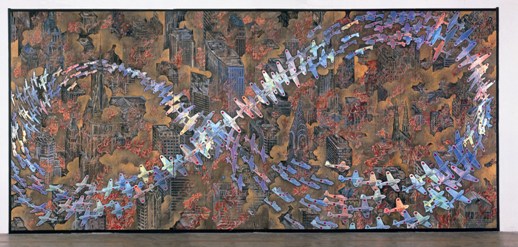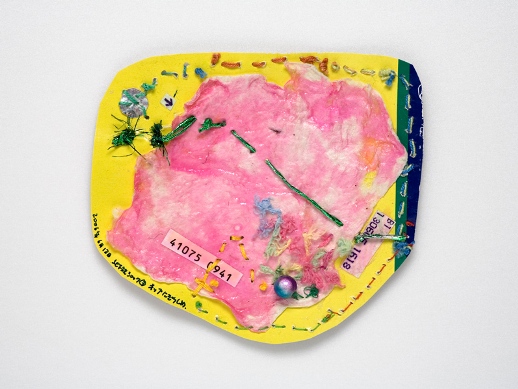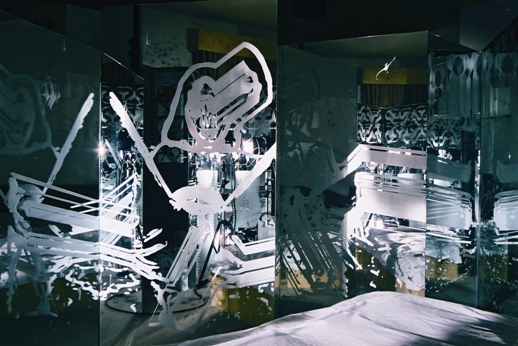A Playground of the Psyche
The traveling exhibit “Neoteny Japan” stems from what curators Mayumi Uchida and Yayoi Kojima describe as “the current landscapes of youngster’s hearts.” The show consists of panoply artworks assembled from the personal collection of psychiatrist Ryutaro Takahashi. Dr. Takahashi was first impressed by Yayoi Kusama’s experimental artworks in the 1960s and began acquiring artworks for his office in the early 1990s. Once he started buying contemporary art he got addicted and began collecting substantial artworks while Japan’s economic bubble was deflating in the late 1990s. He became an early scout in the rising genre of art that was springing up from anime, manga, and kawaii subcultures. With his new space that opened in Hibya this spring Takahashi sets a new standard for the role of private collectors in contemporary Japanese art.
The title “Neoteny” refers to the juvenile characteristics of Japanese society, eloquently described by Takeo Doi nearly forty years ago, that has more recently blossomed in the popularity of otaku fantasies. Childlike emotions are captured by many of the artists in the current exhibition, occasionally reaching an animal-like presence that reveals to the acute visitor the subconscious layers of the human psyche. The arrangement of the artworks lacks a clean narration; like the mind itself, it is a compendium of dream-like reality held together with liminal thoughts.
The Ueno Royal Museum overflows with curiosities of the mind assembled in a way that only a social psychiatrist could. The show may be misinterpreted as a survey of contemporary Japanese art since 1990, but it is more useful to think of the works as a collection of works inspired by the personal tastes and interests of Takahashi himself. In summary, art that springs from and feeds the psyche. Thus the current show moves fluidly in and out of phantasmagoric streams of consciousness, reading more as a form of visual therapy rather than a statement on the condition of Japanese art.

Although the show purports to express the spirit of ‘young’ artists in Japan it opens early on with a room of paintings by Yoshitomo Nara, soon followed by one of Takashi Murakami’s monotonous DOB dolls, flanked by Makoto Aida’s ‘A Picture of an Air Raid on New York City (War Picture Returns)’. Based on a first impression it appears that “Neoteny Japan” may be just another display of superficial otaku subculture. But in fact the show builds intrigue as one enters the caverns of the psyche, reaching a climax in the back room with space-like works on paper from Hiroe Saeki and handmade collages based on everyday walking actions by Sayaka Akiyama.

One of the most outstanding pieces by Akiyama frankly describes the day before she left Berlin in a poetic manner with emotions that anyone who has lived in a foreign country can identify with. Unfortunately the installation of Akiyama’s works was less than splendid, with the English translation of her German/Japanese wall text hidden around the corner by the stairs. This was compounded by the fact that her works were split into entirely separate galleries, placing her current site-specific works in an easily overlooked area adjoining the museum exit. Be sure not to miss this amorphous gallery that also includes the enchanting kaleidoscopic room ‘MUTED SPACE’ by Tadasu Takamine, but also some underwhelming works by the artist known as Mr..

The show, with its lack of translation and domestic tour schedule, is aimed toward a Japanese audience. It opened in Kagoshima last year, moved to Sapporo and will go to four more venues across Japan. The danger of a show claiming to be as broad-sweeping as “Neoteny Japan” is that it becomes a false signifier for “contemporary Japanese art” as a whole. There are many young artists whose work speaks a different language from the “zoological” origins that Takahashi points towards in his adaptation of the scientific term Neoteny. In the current waves of Japanese art Yoshito Ikeda’s subtle video works and Toshiaki Tomita’s socially engaged projects present a remarkably different narrative of contemporary Japanese art. So long as we see the show as one current in a larger river of art practice in Japan the psychological ride is full of thrills and a lot cheaper than a visit to the local therapist’s office.
James Jack
James Jack



